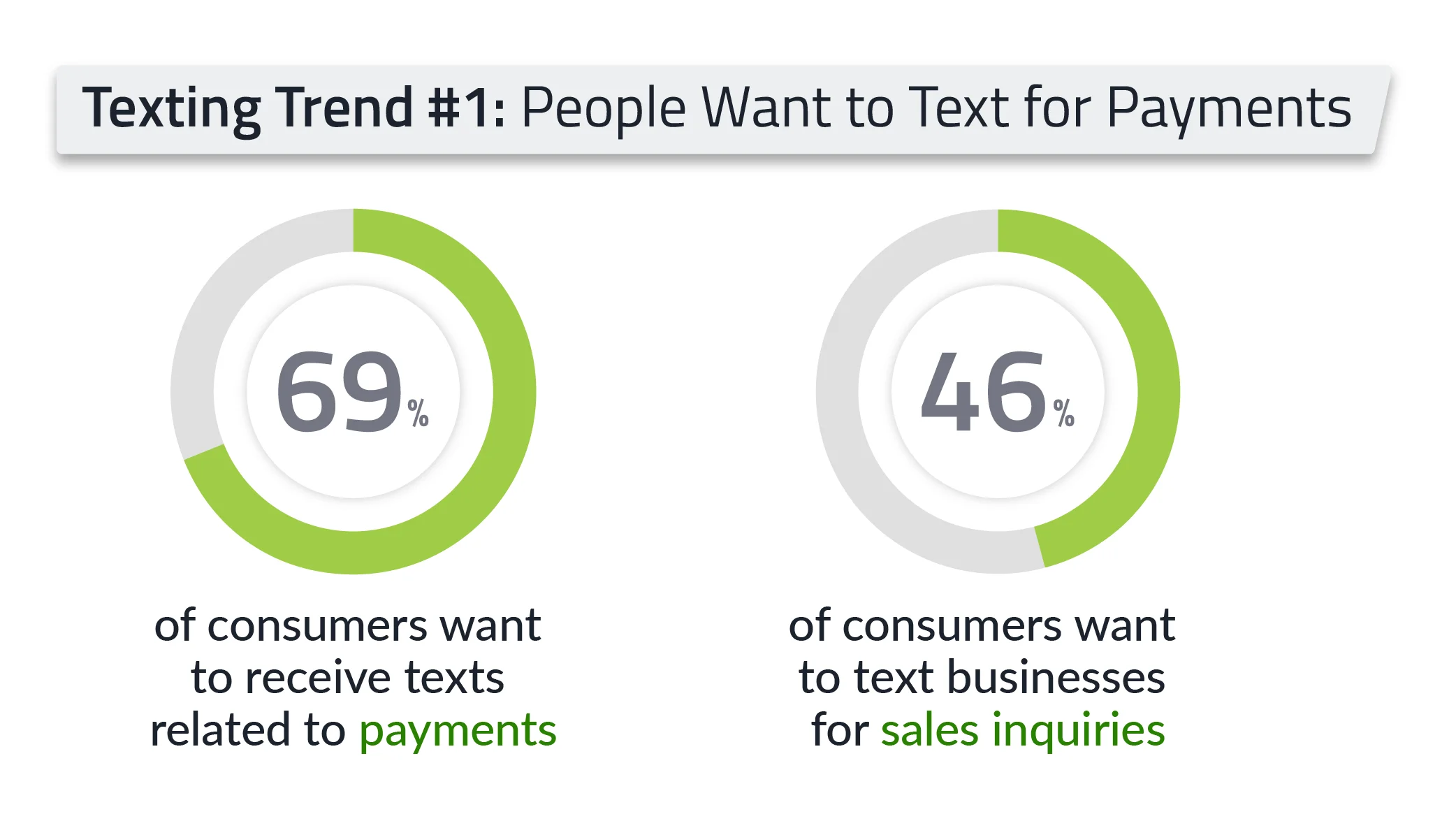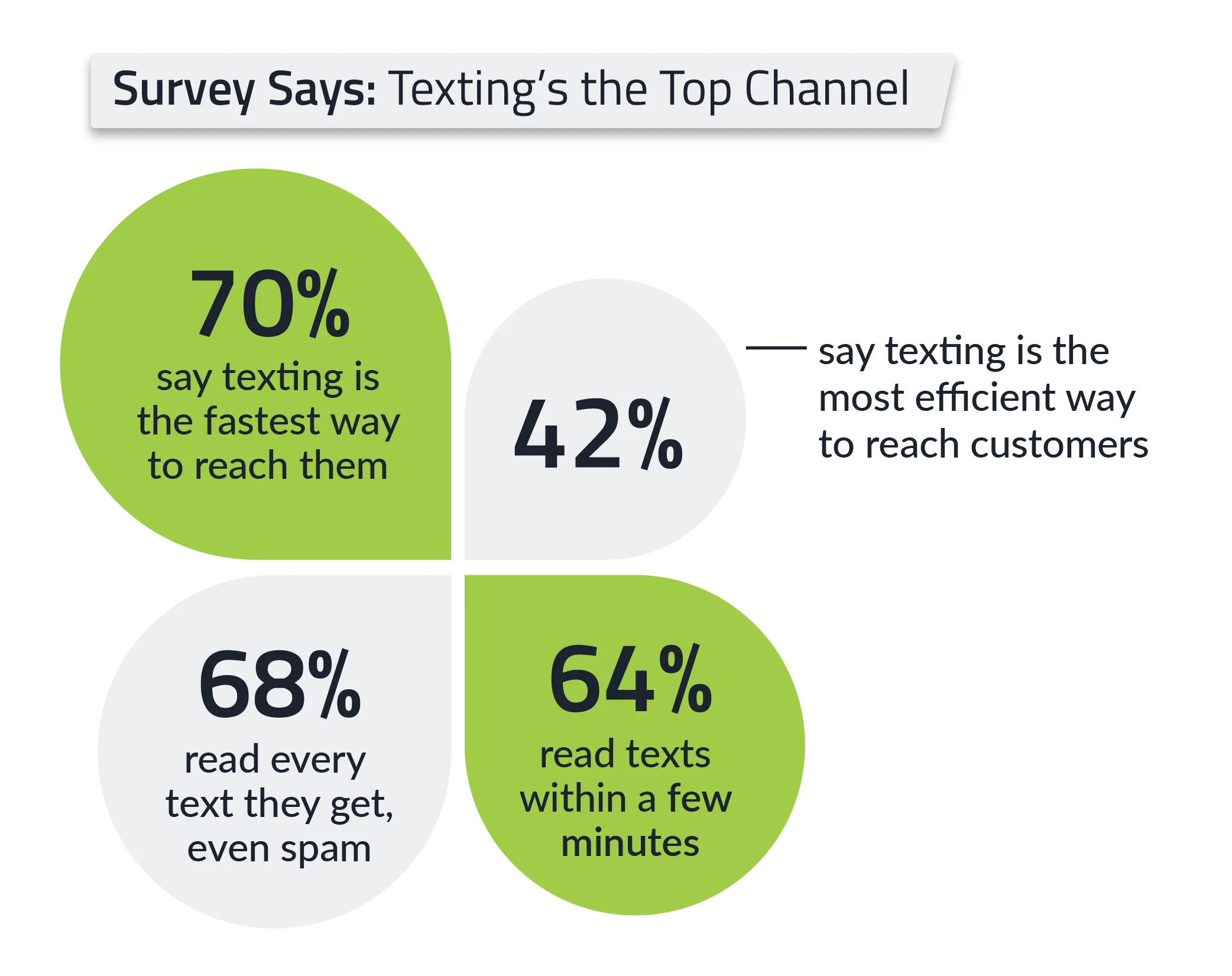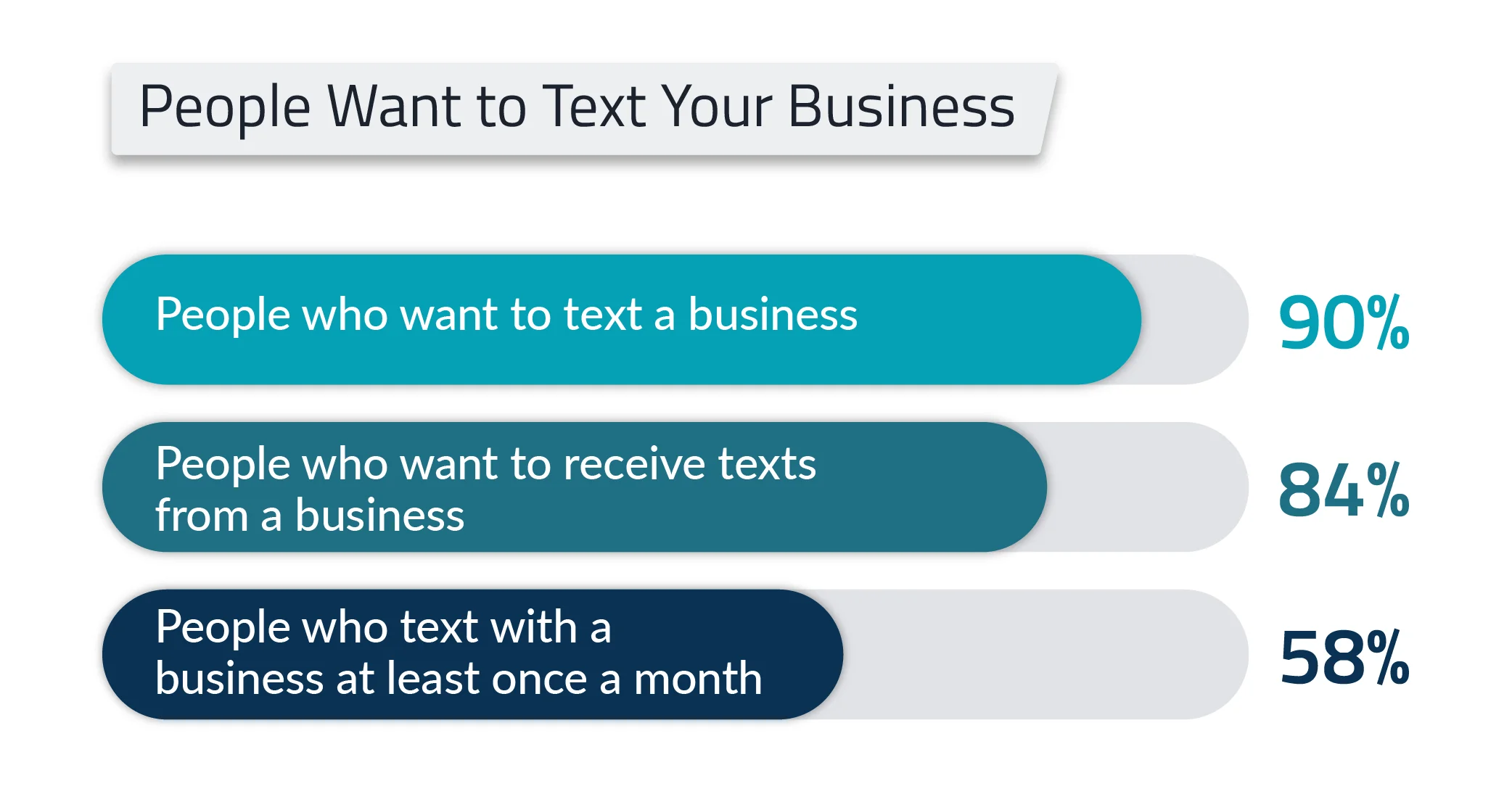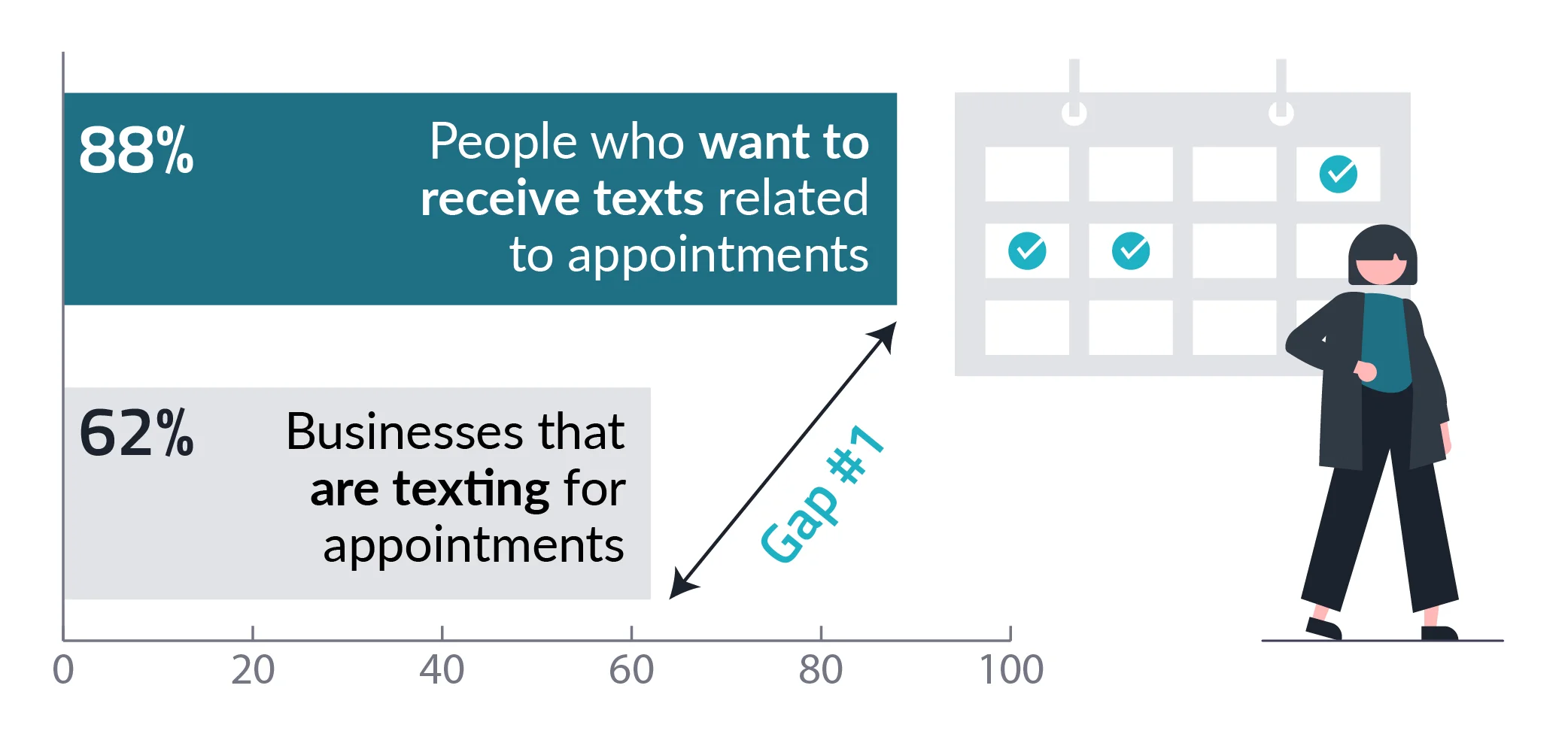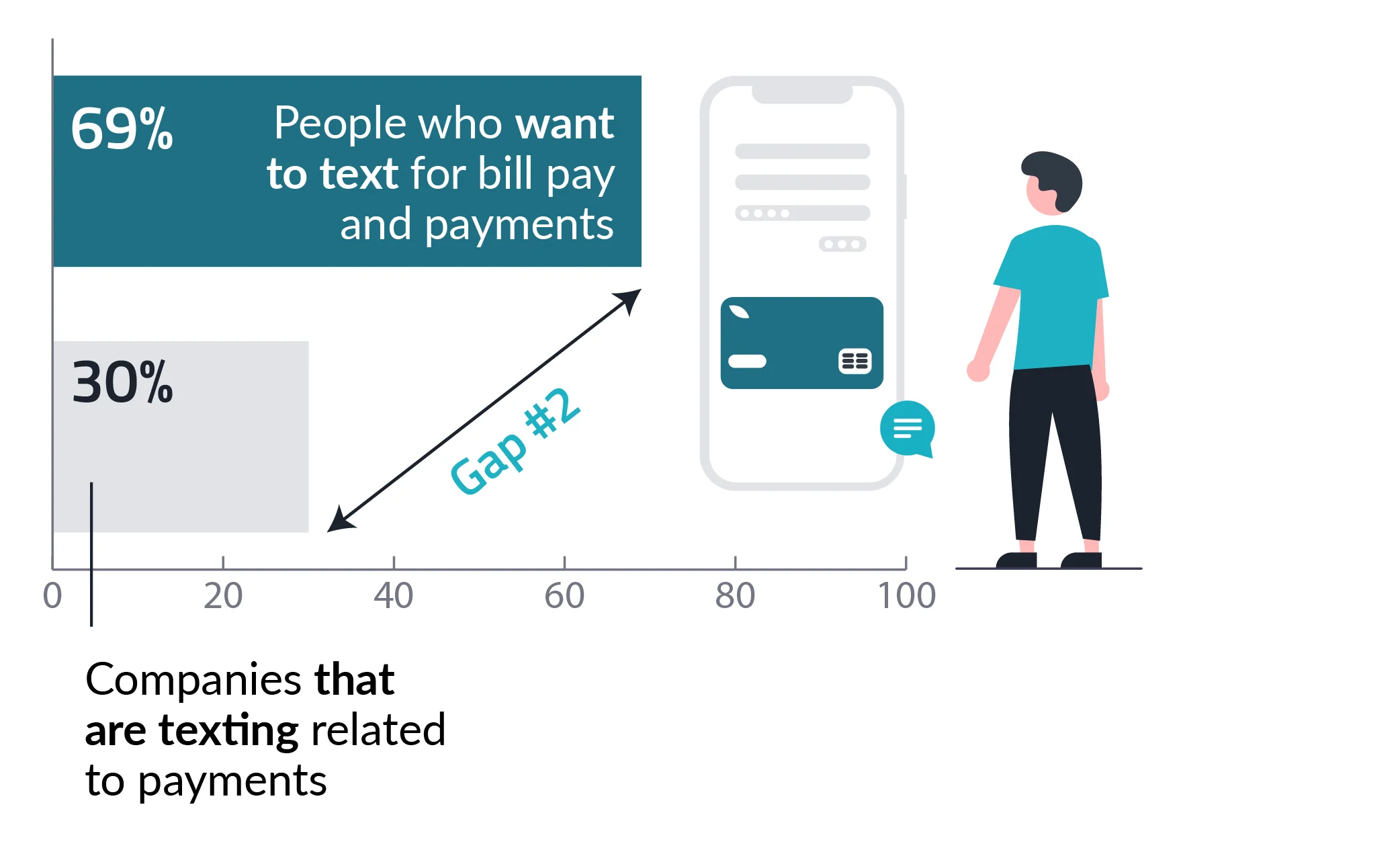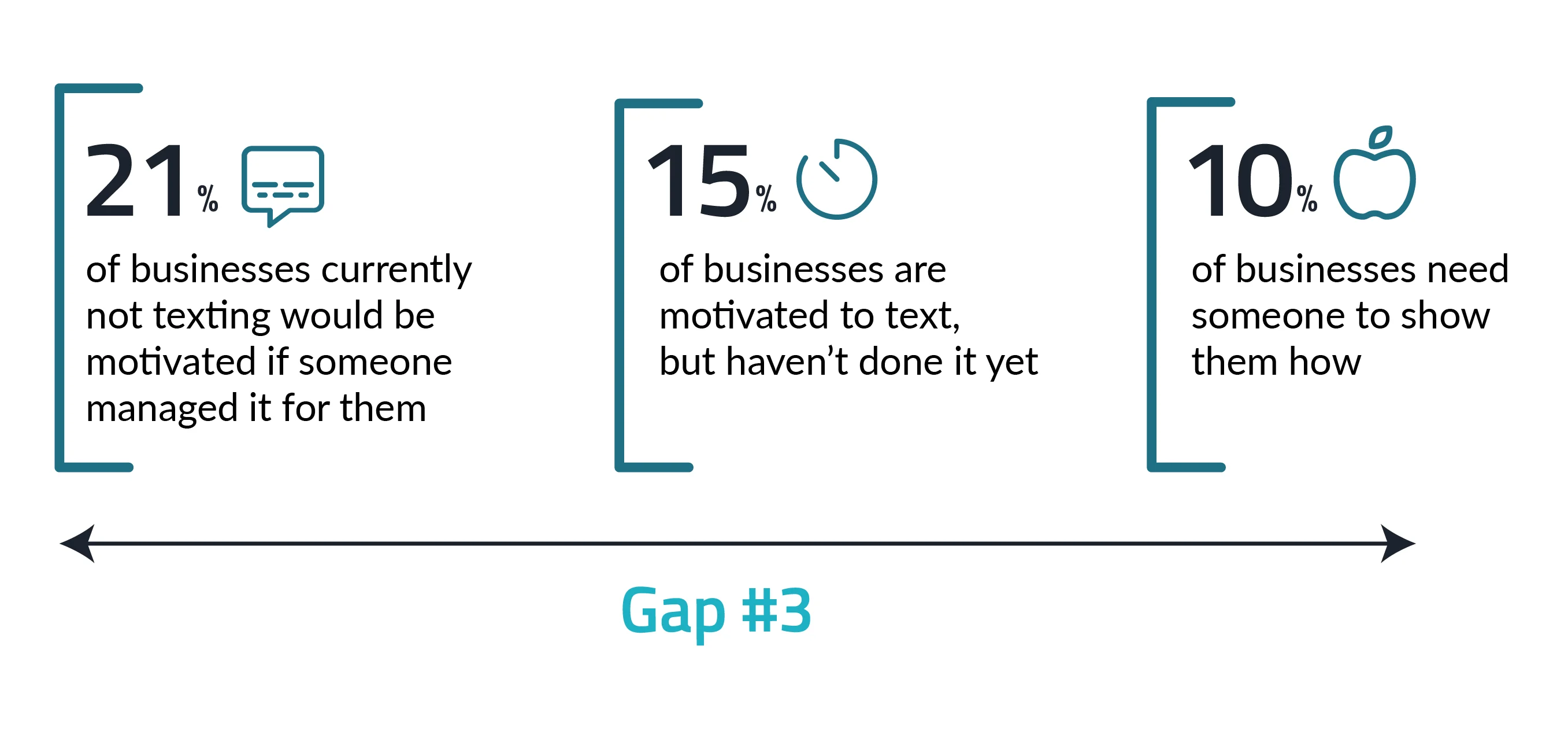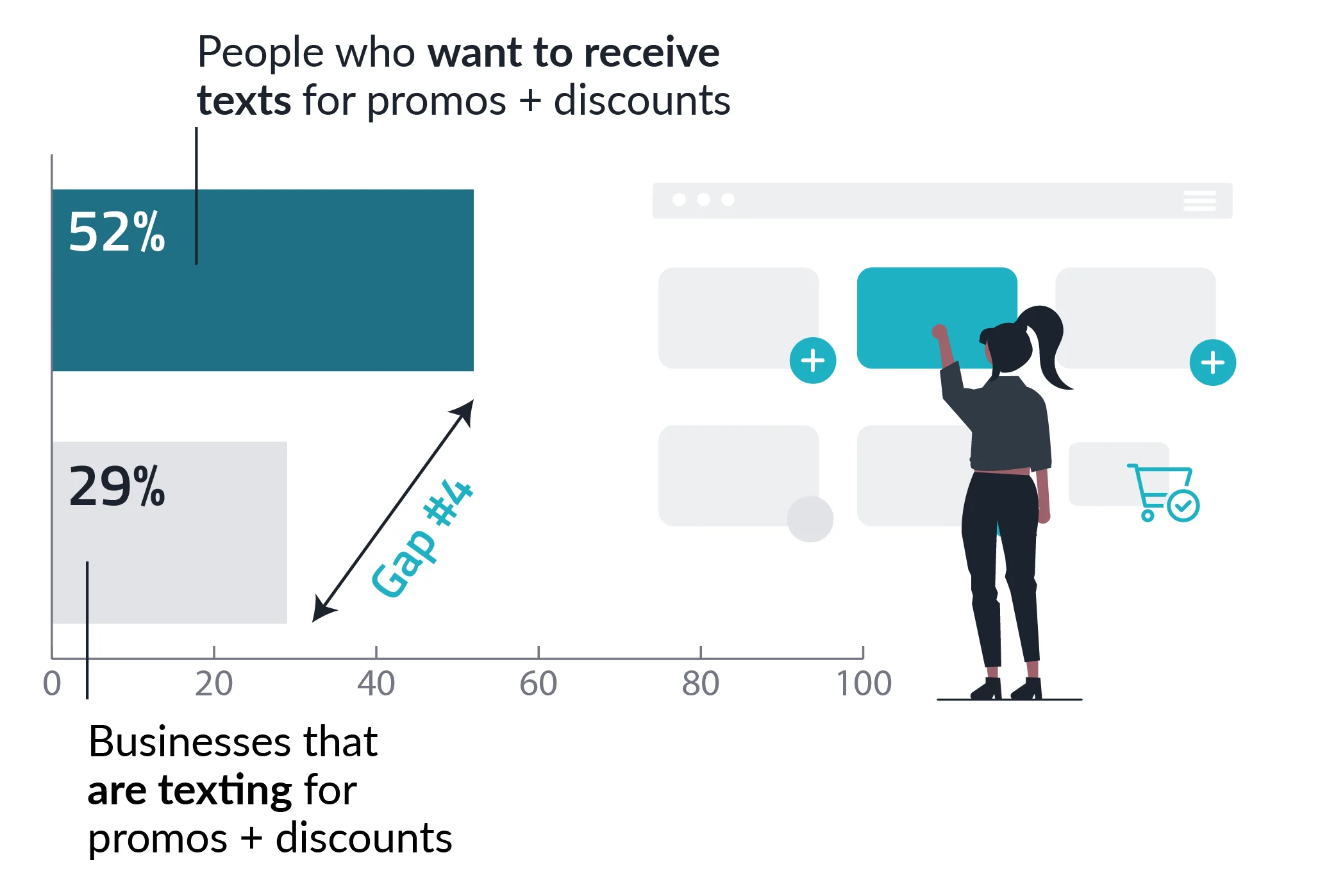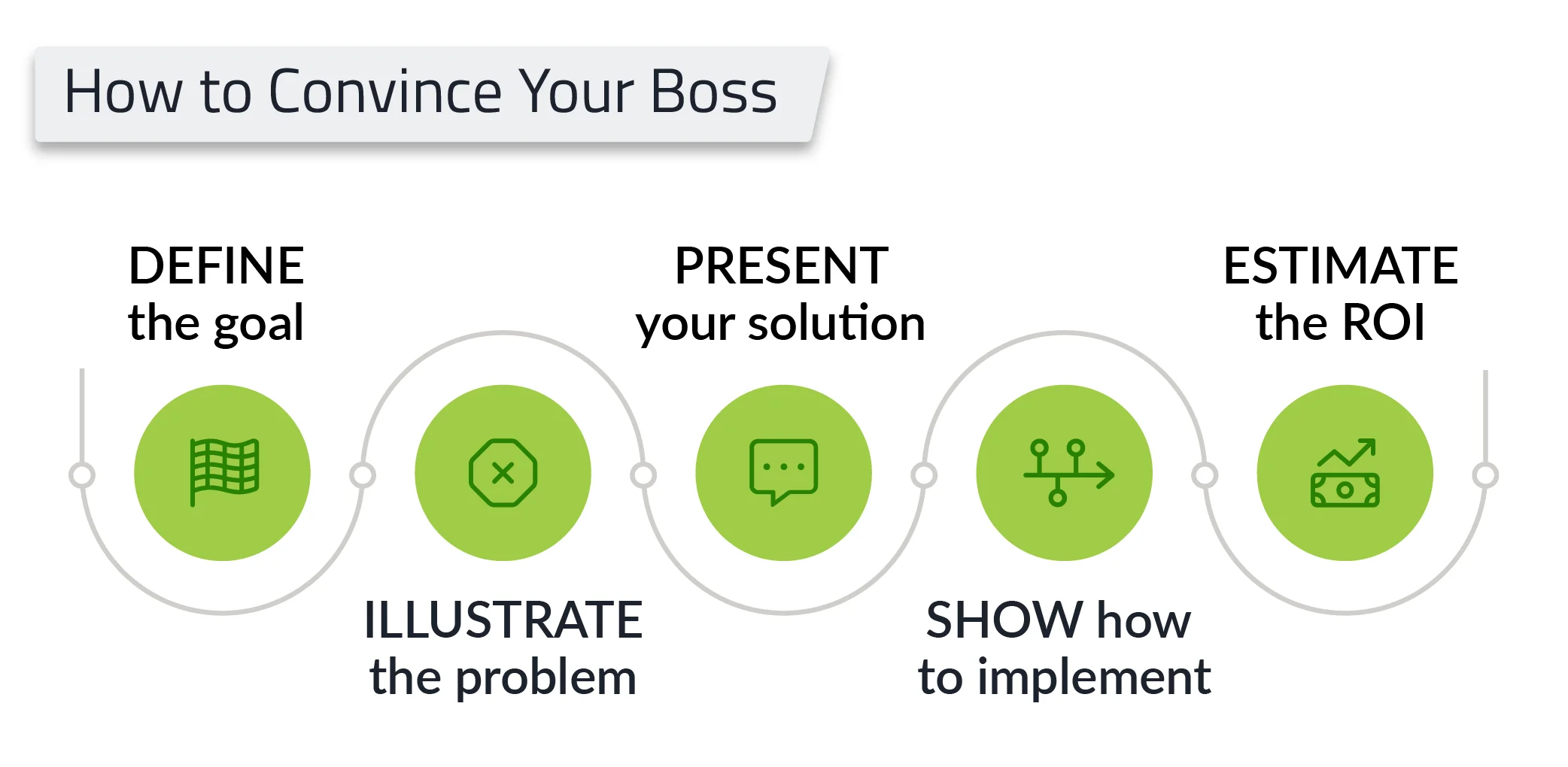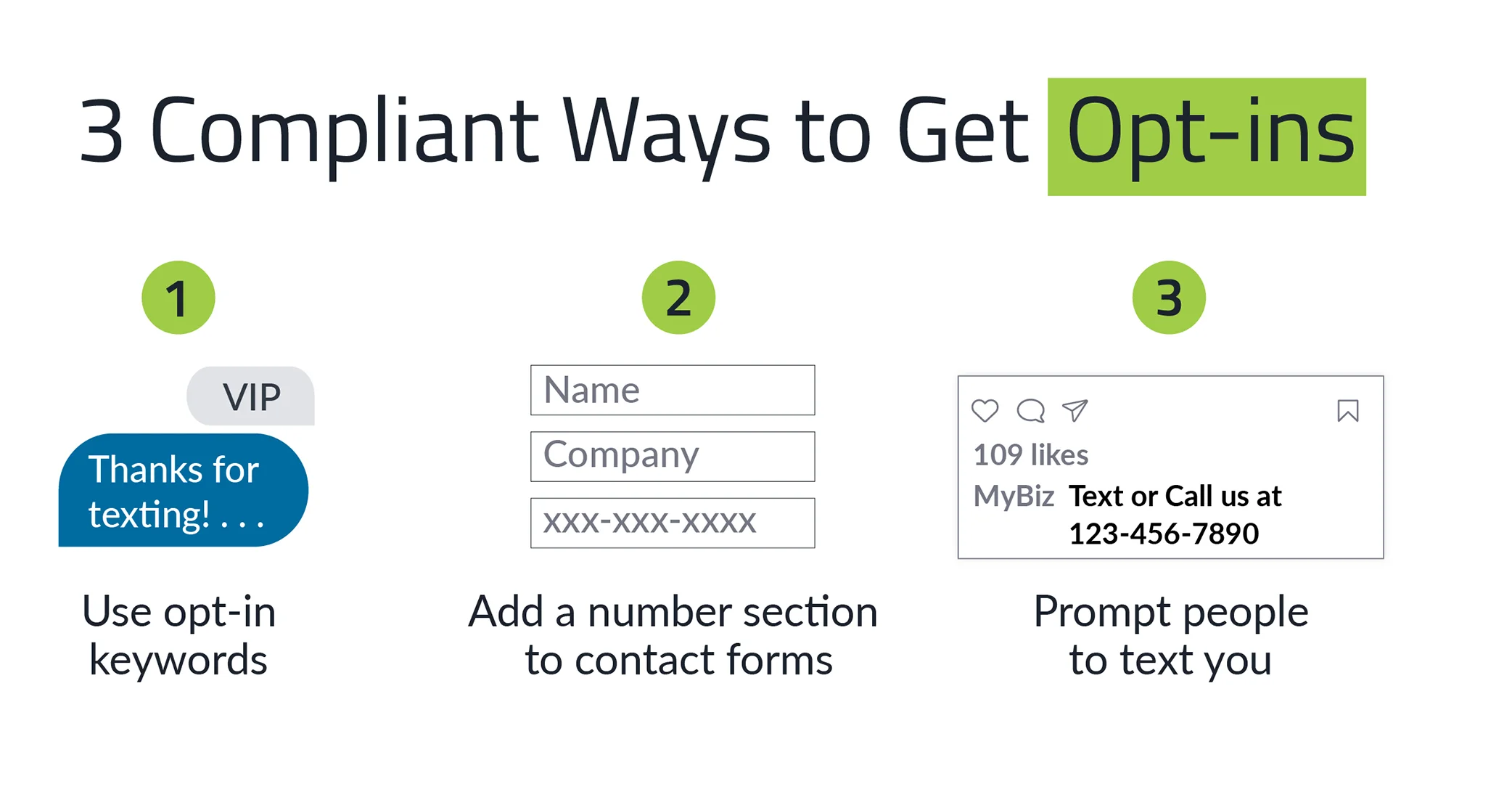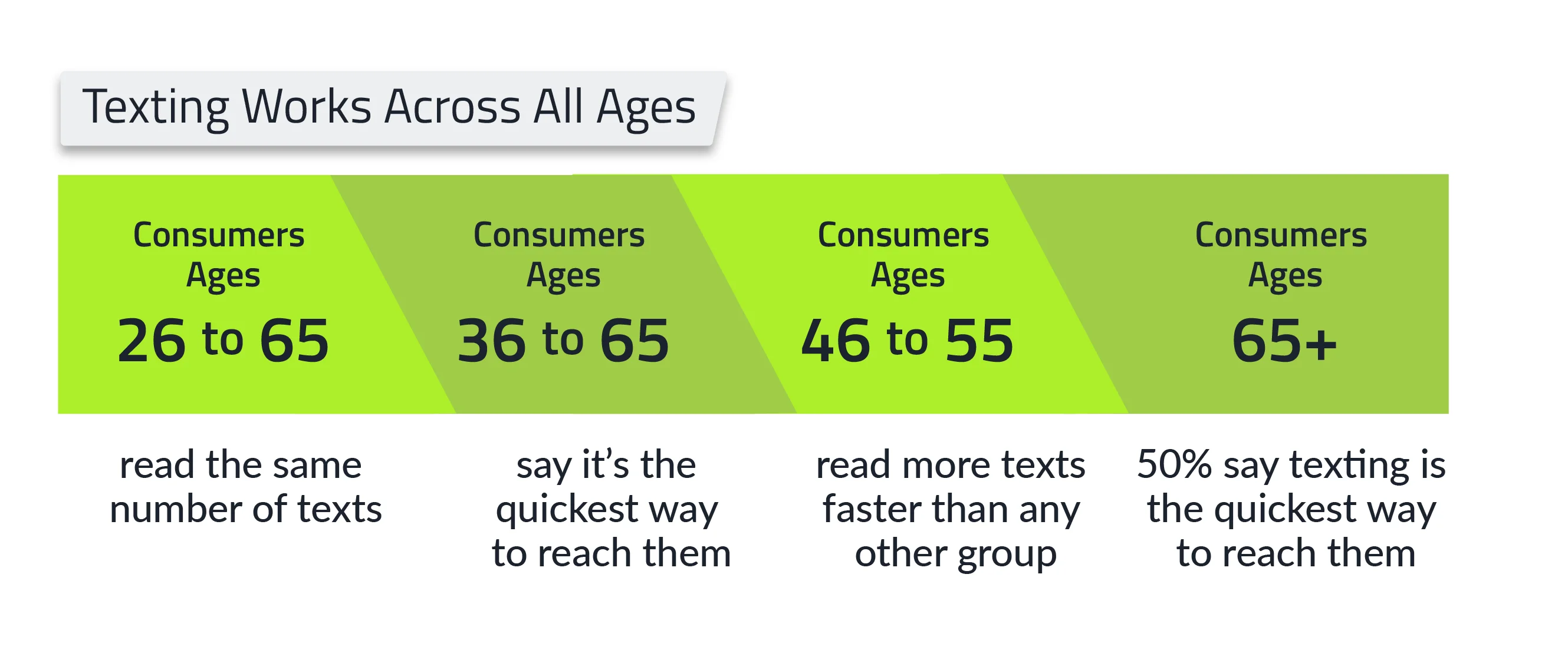Report
2023 State of Business Texting Report
Business texting is booming. We can see that from Google search trends and our own internal data, but we wanted to dive deeper.
What does business texting look like to those actually doing it, and what trends can we expect to bloom throughout 2023? We surveyed over 1,000 people to find out three things:
What do consumers want?
What are businesses doing?
Where are the gaps that need to be filled?
This report answers those questions and more to create a clearer picture of the state of business texting in 2023. We’re also providing action steps based on this data to create better customer experiences and drive revenue.
Sound good?
We know you’re going to skim this, so we’ve made skimming easy, but the most interesting details are in the paragraph descriptions.
If you're on a computer, use the outline in the top left to jump around. If you just want the stats, scroll down to the Texting Statistics section at the bottom. There are plenty.
What is business texting?
Business texting is sending and receiving texts professionally as an organization, typically through your office phone number, and typically using a business texting service like Text Request. Think of it like your business email or a shared inbox, but for texting.
This is what we have in mind as we talk about all the data and insights below. For answers to common questions and help texting successfully, view our Complete Guide to Business Texting.
Top 3 Texting Trends for 2023
These are the biggest business SMS topics you need to pay attention to, and what you should do about them.
1. Commerce isn’t just mobile, it’s conversational.
The biggest new trend we’re seeing is that consumers want to buy things through text. “Conversational commerce” is the buzzword we’re supposed to use, but the down-to-earth version is three things are happening:
Prospects are texting with sales reps about products and services
Customers are asking for payment reminders and bill pay options through SMS
Businesses are getting comfortable taking payments through text
The entire transaction is happening via SMS, and everyone involved is having a good experience. Prepare to hear “text-to-pay” more in 2023, and to see more sales and billing teams add texting to their communications mix.
Not included in this data but worth noting, “text-to-give” for nonprofit fundraising has been increasing in both popularity and effectiveness.
Notable Statistics
69% of consumers want to receive texts related to making payments
46% of consumers want to text businesses for sales inquiries
2. Texting is categorically more convenient than talking.
The #1 write-in answer for “Why did your organization start texting?” was “convenience.”
Business leaders have grown tired of playing phone tag with customers and employees, and have turned to texting to get responses. “Convenience” is a bit of a catchall, though, so let’s break it down.
People tend to enjoy texting more than other forms of communication. Phone calls are interruptive, and email is viewed as overkill for many communications, but a text fits smoothly into people’s days. It doesn’t have to be responded to immediately, and takes little effort when you’re ready.
80% of people have texted with a business before, and enough of them have had good experiences that it’s become an expectation. We’re seeing consumers quietly refuse to work with businesses who do not offer this convenience, and we’re seeing businesses having to text just to get their work done.
Consumers do not un-learn convenience, so we expect this trend to gain speed. 2023 will give us a sweet spot where texting with customers is a competitive advantage but not yet oversaturated.
Notable Statistics
88% of people want to receive appointment scheduling texts from businesses
77% of people want to text for customer service
70% of people say texting is the fastest way to reach them
67% of businesses started texting to get faster responses
3. Significantly more businesses will be texting soon.
Business texting is a relatively young market, but we now expect 2023 to be a bumper crop of a year. A few reasons why:
Increasing referrals and chatter around business texting services
Heavier investments in telecommunications infrastructure to verify and deliver business messages
Business buyers are making decisions faster and with deeper planning
Having more businesses and other organizations texting is great for providers like us. It also means you need to act now. Implement or expand your texting strategy, so you can strengthen customer relationships before competitors have a chance to work their way in.
Notable Statistics
98% of people texting would recommend it to another business
42% of those not currently texting in their organizations are actively working to implement it, or are planning to implement it this year
The average business that’s texting is doing so for 3+ use cases, more than in past years
Old Trends Still Trending
There’s a fair argument to make that these are no longer “trends,” but simply the new state of customer engagement.
1. Texting is the fastest way to reach someone and get a response.
Most people say texting is the fastest way to reach them, and there are two interesting developments.
Fewer people read every single text. We think that’s because of an increase in texts being sent by political groups and spammers. That also fits with the reasoning behind 10DLC carrier regulations enforced in 2022 (for details, view our 10DLC regulations guide).
People are better at filtering distractions. There was a time when nearly every text was read almost instantly. Then people realized how distracting that was. Now they tend to take breaks to check notifications. You’re still going to get a response, you may just need to wait a bit longer.
Notable Statistics
70% say texting is the fastest way to reach them
42% of businesses say the most effective way to reach customers is texting
64% of people read texts within a few minutes
68% of people read every text they get, even the spam
2. Most people want to text with businesses.
We’ve seen this hold steady for about five years. Some people do not want to text with a business, and that’s fine. Most people do, and that means businesses need to enable it as a communications channel.
We also find it interesting that 90% of people want to text a business, yet only 80% of people have. There’s still room to delight customers with new experiences.
Notable Statistics
90% of people want to text a business
84% want to receive texts from a business
58% of people text with a business at least once a month
Biggest Texting Gaps and Opportunities
There’s a mismatch between what consumers say they want, and what businesses are offering. This section highlights those gaps, and shows how to close them.
1. The #1 thing consumers want to text for is appointment scheduling.
Gap: 88% of consumers say they want to receive texts about appointments, yet only 62% say that their businesses are texting for it.
Perhaps appointment scheduling isn’t relevant to some industries, but it is relevant to at least 90% of those represented in this survey. Other research shows that the main reason people miss appointments is because they forgot, and that those missed appointments are costing on average:
Primary Care Doctor - $186
Cleaning Service - $120
Accountant - $150
Salon - $80
Lawyer - $300
Making phone calls and leaving voicemail for appointment reminders is time-consuming and relatively ineffective.
Opportunity: Text for appointment reminders, and prompt customers to schedule their next appointments as appropriate, such as when they’re overdue or for seasonal services. It’s a quick way to add more revenue while cutting costs.
Using Mass Texting and Merge Fields to personalize each text will come in handy here. This will also create the experiences customers say they want.
2. Customers want texts related to payments.
Gap: 69% of consumers want to receive texts for bill pay and payment reminders, yet only 30% of people said their companies are texting for anything related payments.
This is perhaps the most important gap we’re seeing in business, even outside of texting. It directly affects your ability to take in revenue—what’s more important than that? (Acceptable answers include “taking care of your people,” but even that relies on bringing in revenue.)
Opportunity: Add texting into your billing and collections workflows. Examples include sharing invoices through text, sending links to pay online through text, texting payment reminders, requesting payment entirely through text, and texting customers to update their payment info when credit cards expire.
For help accepting payments securely through text, view our Payments feature. For help fitting texting into your invoicing workflows, view our integrations with Quickbooks, Square, and Clio.
3. Businesses want someone to manage texting for them.
Gap: 21% of those not currently texting said they’d be motivated to start if someone managed it for them. An additional 15% said they’re motivated but haven’t done it yet, and another 10% said they need someone to show them how.
People can’t do everything—we can all relate to that—but about half of those not currently texting likely would use the channel if someone managed it for them.
Opportunity: Managed services companies like marketing agencies, virtual assistants, IT firms, and other outsourced business development and operations businesses need to add texting to their list of offerings. There’s clear demand, and an easy upsell.
To explore this opportunity further, view our Partners Program.
Another opportunity is for individuals to develop skills creating successful SMS campaigns and workflows. These skills will be an increasingly in-demand.
4. More businesses should text for promotions and discounts.
Gap: This one surprised us, and it may surprise you, too. 52% of people want to receive texts from businesses about promotions and discounts, yet only 29% of people say their businesses are sending these texts.
A common misconception is that promotional texts are only for retail businesses, but there are opportunities for all.
Opportunity: Send periodic texts for promotional purposes. Examples include:
Inviting past customers to schedule their next appointments
Telling customers about new services
Nonprofit and educational fundraising
Reminders about important deadlines
Discounts, or incentives for taking an action
Prompts or reminders to register for or show up to an event
People want these texts, and they’ll bring your organization needed revenue, so text away!
Major Challenges to Texting as a Business
Everything’s easy when you know what to do—the tough part is figuring it out, but we’re here to help. These are the major roadblocks we see keeping businesses from implementing a solid texting strategy, along with recommendations to kick those roadblocks to the curb.
1. Getting supervisor buy-in.
The #1 reported reason why businesses are not texting is it’s “someone else’s decision.” From the write-in comments, “someone else” typically refers to the boss. We know texting can be valuable, so we’re going to help you sell your supervisor on texting.
Proposed Solution
This is the 5-step framework we’ve seen work for others:
Define the goal
Illustrate the problem
Present your solution (texting)
Show how to implement it, including costs and timeline estimates
Estimate the return on investment, and any additional benefits
Example: Let’s say the goal is to close more signed contracts, and the problem is your phone calls and emails asking clients to sign and pay are not working. You can’t get a response. You think texting will work, because the few times you text clients from your personal cell phone, they respond quickly, and some even reach out to you through text.
You checked out Text Request’s pricing, and think $59/mo is well worth it if you sign even one additional contract, though you’d expect to sign several more. You can have an account set up and several users fully trained within a few days, easy, if not day-of.
Extra benefits include texting from a business line that’s actually secure and compliant, because texting from a personal cell phone is not. Plus, if and when employees leave, all of that data stays with you.
If it’s helpful, share this report, view a demo, reference our security page, and feel free to contact us for anything you may need.
2. Compliance and getting customers to opt in.
Compliance and contact opt-ins tend to be two sides of the same coin, so we’re covering both here. We’ll also cover what to do if your contact phone numbers are all landlines.
Note: We are not lawyers and this does not constitute legal advice.
Most organizations can text compliantly. Notable exceptions include those in the hemp or cannabis space and those in third-party debt collections. There’s too much nuance for texting in those industries to cover here, so we won’t. But you should know that texting in healthcare and financial services can be fully compliant, and is often encouraged.
Proposed Solution
Compliance: Big picture, it only takes three things to text compliantly.
Contacts need to opt in to messages from you
Contacts need to be told how to opt out at any time
All data needs to be encrypted in transit and at rest
Text Request takes care of these three things for you, so you’d have to go out of your way to text non-compliantly. If you like, you can include a link to your disclosures in the text. We also have HIPAA compliant texting accounts, specifically.
A few things you can’t do when texting compliantly:
Buy a list of contacts, or text random numbers
Text people who’ve opted out
Delete your data
Opt-ins: You’re allowed to contact customers and employees who’ve given you their contact info. After that, a few quick ways to get people to opt in:
Create an opt-in keyword like VIP, and tell people what they’ll get for subscribing. Then promote this through your standard channels, ongoing.
On your contact forms, add a field for “Cell Phone” and a disclosure that by giving you their contact info you are allowed to contact them.
Prompt people to text you. E.g. on your website or in store, say “Text or call us at… for…”
For more ideas and a full strategy on getting opt-ins, view our guide to building an SMS subscriber list.
Contact numbers are landlines: First, just ask us to scan your contact list. We’ll tell you how many of those phone numbers are cell numbers, and how many are landlines. That way you know exactly where you stand.
Second, you will need to either reach out to contacts to get updated contact info, or begin asking specifically for cell phone numbers on your forms. We recommend both.
3. Determining return on investment.
56% of people said they’re not able to track ROI on their texting efforts, yet the vast majority of use cases should provide a clear return. We don’t see this as a complaint from survey respondents, but we know “that which gets measured gets better.”
From this, we have one recommendation and one takeaway for our own platform.
Proposed Solution
Recommendation: Managers, share your business reasoning with employees. How much time or money do you save or make by doing this? Employees are more engaged and effective when they can see the “why” behind their actions, and can tie those actions to clear results.
Takeaway: We know it’s valuable to track return on investment. There’s room for us to add more tools and resources into Text Request to make tracking and reporting easier for all users, not just account admins.
Business Texting Myths That Need Busting
1. Texting is only for B2C, not B2B.
A quote from one of our survey respondents lines up with what we sometimes hear in other conversations: “I can see value for B2C, difficult for B2B.” However, the data disagrees.
B2B buyers increasingly expect B2C experiences. Business buyers are also average consumers outside of work. 80% of them have texted with a business before, and it’s increasingly becoming an expectation.
Many of the same use cases that apply to B2C also apply to B2B. A few examples include:
Appointment scheduling during sales, customer service, and hiring processes
Payment reminders and collections (bill pay)
Upsell and new service promotions, as applicable
Customer service and general communications
Everyone texts, so can every business.
2. Businesses only text for mass marketing.
We sometimes hear “I’m not sure how text marketing would work [for us].” It also showed up in survey responses. What’s interesting is that we do not talk about text marketing in these conversations. The other person assumes texting is for marketing purposes only.
29% of people said their businesses are texting for marketing and promotions. Meanwhile, the top use case is customer service—back and forth conversations about accounts, support, product ordering, appointments, and all the questions that come up along the customer journey.
Our report shows most businesses text for customer conversations and quick updates, not marketing. Business communications in general have shifted from phone calls to text messages.
3. Texting only works for younger demographics.
Has someone said your employee base is “older” and therefore doesn’t text? We now have data to show that’s false.
Adults 26–65 years old read the same number of texts
An equal percentage of adults from 36–65 say texting is the quickest way to reach them
50% of adults 65+ years old say texting is the quickest way to reach them
Adults 46–55 years old are actually the most likely demographic to read more texts faster
All generations text. You do your organization a disservice by excluding it.
Methodology
We created a survey with three sections: texting as a consumer, texting as an organization, and demographic info. We shared this survey with our customers, non-customer subscribers, and others with similar psychographic and demographic profiles. We used Typeform to create the survey, which estimated it would take five minutes to complete, and offered one entry to win $1,500 for completing it.
We distributed the survey through Text Request in-app notifications, email, and across social media platforms (LinkedIn, Facebook, Instagram, and Twitter), both organically and through ads. We collected data between October 11, 2022 and November 1, 2022. Most responses came from in-app notifications and email, and mostly from existing customers (80%).
All responses were verified for accuracy and completeness. After removing unverified submissions and multiple responses from the same contacts, we collected 1,004 unique responses representing 866 unique organizations. Respondents also represented at least 11 roles in 17 industry categories across the United States and Canada. Two respondents reported as being Under 18 years old, 24 respondents reported being 65+ years old, and the rest fell between 18–65 years old.
All data is based on self-reporting. We recognize this creates room for human error, however, there is no way to get objective facts for many of these questions, such as “How quickly do you read texts?”
Data We Didn’ t Include and Why
We asked every respondent one question, but left it out of the report. “Which channels does your organization use to reach customers and other contacts?” The top four responses were 92% for email, 90% for phone calls, 87% for text messaging, and 60% for social media.
On the surface, it looks like most businesses are already texting—almost as many as are calling and emailing. However, 80% of respondents were existing customers, and we felt that might skew the data. While it’s interesting that many non-customers are already texting, we did not think it accurately represented the state of the industry, so we left it out of this report.
Other questions we did not ask include:
Why wouldn’t you read a text?
Why would you choose to text [in certain situations]?
How many texts do you send and receive each day?
How many contacts does your business text in a given time period?
How many texts does your business send and receive each day (or month)?
We did not ask these and related questions for three reasons:
We wanted to keep survey time-to-complete to five minutes or less
These questions do not get at the heart of what consumers want and how businesses are responding
It’s tough to get accurate data for these questions from self-reporting, though we could from internal reporting
Future studies will build on this report, and we’re likely to ask some of these “missing” questions then.
201 Texting Statistics for 2023
How many texts do people read?
69% of people read every text they get
13% of people read 9 out of 10 texts they get
8% of people read 8 out of 10 texts
4% of people read 7 out of 10 texts
2% of people read 6 out of 10 texts
2% of people read 5 out of 10 texts
2% of people read less than half the texts they get
By age range
18–25 years old:
62% of people 18–25 years old read every text they get
16% of people 18–25 years old read 9 out 10 texts
9% of people 18–25 years old read 8 out 10 texts
7% of people 18–25 years old read 7 out 10 texts
5% of people 18–25 years old read 6 out of 10 texts
1% of people 18–25 years old read 5 out of 10 texts
0% of people 18–25 years old read less than half the texts they get
26–35 years old:
69% of people 26–35 years old read every text they get
13% of people 26–35 years old read 9 out of 10 texts
7% of people 26–35 years old read 8 out of 10 texts
4% of people 26–35 years old read 7 out of 10 texts
1% of people 26–35 years old read 6 out 10 texts
3% of people 26–35 years old read 5 out 10 texts
2% of people 26–35 years old read less than half the texts they get
36–45 years old:
70% of people 36–45 years old read every text they get
11% of people 36–45 years old read 9 out of 10 texts
11% of people 36–45 years old read 8 out of 10 texts
4% of people 36–45 years old read 7 out of 10 texts
1% of people 36–45 years old read 6 out of 10 texts
2% of people 36–45 years old read 5 out of 10 texts
2% of people 36–45 years old read less than half the texts they get
46–55 years old:
71% of people 46–55 years old read every text they get
14% of people 46–55 years old read 9 out of 10 texts
6% of people 46–55 years old read 8 out of 10 texts
3% of people 46–55 years old read 7 out of 10 texts
1% of people 46–55 years old read 6 out 10 texts
1% of people 46–55 years old read 5 out of 10 texts
3% of people 46–55 years old read less than half the texts they get
56–65 years old:
69% of people 56–65 years old read every text they get
15% of people 56–65 years old read 9 out of 10 texts
8% of people 56–65 years old read 8 out of 10 texts
4% of people 56–65 years old read 7 out of 10 texts
1% of people 56–65 years old read 6 out of 10 texts
0% of people 46–65 years old years old read 5 out of 10 texts
4% of people 56–65 years old read less than half the texts they get
65+ years old:
46% of people 65+ years old read every text they get
17% of people 65+ years old read 9 out of 10 texts
21% of people 65+ years old read 8 out of 10 texts
8% of people 65+ years old read 7 out of 10 texts
4% of people 65+ years old read 6 out of 10 texts
4% of people 65+ years old read 5 out of 10 texts
1% of people 65+ years old read less than half the texts they get
How fast do people read texts?
14% of people read texts instantly, as soon as they come in
50% of people read texts within a few minutes of receiving them
19% of people read texts within 30 minutes of receiving them
12% of people read texts within 1 hour of receiving them
3% of people take more than 1 hour to read new texts
2% of people take more than 6 hours to read new texts
1% of people take more than 24 hours to read new texts
By age range
18–25 years old:
15% of people 18–25 years old read new texts instantly
53% of people 18–25 years old read new texts within a few minutes
12% of people 18–25 years old read new texts within 30 minutes
15% of people 18–25 years old read new texts within 1 hour
2% of people 18–25 years old take more than 1 hour to read new texts
2% of people 18–25 years old take more than 6 hours to read new texts
1% of people 18–25 years old take more than 24 hours to read new texts
26–35 years old:
13% of people 26–35 years old read new texts instantly
45% of people 26–35 years old read new texts within a few minutes
22% of people 26–35 years old read new texts within 30 minutes
14% of people 26–35 years old read new texts within 1 hour
3% of people 26–35 years old take more than 1 hour to read new texts
1% of people 26–35 years old take more than 6 hours to read new texts
1% of people 26–35 years old take more than 24 hours to read new texts
36–45 years old:
16% of people 36–45 years old read new texts instantly
49% of people 36–45 years old read new texts within a few minutes
21% of people 36–45 years old read new texts within 30 minutes
9% of people 36–45 years old read new texts within 1 hour
3% of people 36–45 years old take longer than 1 hour to read new texts
2% of people 36–45 years old take longer than 6 hours to read new texts
0% of people 36–45 years old take longer than 24 hours to read new texts
46–55 years old:
13% of people 46–55 years old read new texts instantly
56% of people 46–55 years old read new texts within a few minutes
16% of people 46–55 years old read new texts within 30 minutes
10% of people 46–55 years old read new texts within 1 hour
3% of people 46–55 years old take longer than 1 hour to read new texts
2% of people 46–55 years old take longer than 6 hours to read new texts
0% of people 46–55 years old take longer than 24 hours to read new texts
56–65 years old:
13% of people 56–65 years old read new texts instantly
49% of people 56–65 years old read new texts within a few minutes
19% of people 56–65 years old read new texts within 30 minutes
12% of people 56–65 years old read new texts within 1 hour
5% of people 56–65 years old take longer than 1 hour to read new texts
1% of people 56–65 years old take longer than 6 hours to read new texts
1% of people 56–65 years old take longer than 24 hours to read new texts
65+ years old:
13% of people 65+ years old read new texts instantly
46% of people 65+ years old read new texts within a few minutes
13% of people 65+ years old read new texts within 30 minutes
21% of people 65+ years old read new texts within 1 hour
8% of people 65+ years old take longer than 1 hour to read new texts
0% of people 65+ years old take longer than 6 hours to read new texts
0% of people 65+ years old take longer than 24 hours to read new texts
What is the quickest way to reach someone?
70% of people say a text message is the quickest way to reach them
22% of people say a phone call is the quickest way to reach them
7% of people say an email is the quickest way to reach them
1% of people say a social media direct message is the quickest way to reach them
By age range
18–25 years old:
60% of people 18–25 years old say a text message is the quickest way to reach them
28% of people 18–25 years old say a phone call is the quickest way to reach them
9% of people 18–25 years old say an email is the quickest way to reach them
3% of people 18–25 years old say a social media direct message is the quickest way to reach them
26–35 years old:
67% of people 26–35 years old say a text message is the quickest way to reach them
24% of people 26–35 years old say a phone call is the quickest way to reach them
8% of people 26–35 years old say an email is the quickest way to reach them
1% of people 26–35 years old say a social media direct message is the quickest way to reach them
36–45 years old:
74% of people 36–45 years old say a text message is the quickest way to reach them
19% of people 36–45 years old say a phone call is the quickest way to reach them
5% of people 36–45 years old say an email is the quickest way to reach them
1% of people 36–45 years old say a social media direct message is the quickest way to reach them
46–55 years old:
75% of people 46–55 years old say a text message is the quickest way to reach them
17% of people 46–55 years old say a phone call is the quickest way to reach them
8% of people 46–55 years old say an email is the quickest way to reach them
1% of people 46–55 years old say a social media direct message is the quickest way to reach them
56–65 years old:
73% of people 56–65 years old say a text message is the quickest way to reach them
22% of people 56–65 years old say a phone call is the quickest way to reach them
5% of people 56–65 years old say an email is the quickest way to reach them
0% of people 56–65 years old say a social media direct message is the quickest way to reach them
65+ years old:
50% of people 65+ years old say a text message is the quickest way to reach them
42% of people 65+ years old say a phone call is the quickest way to reach them
8% of people 65+ years old say an email is the quickest way to reach them
0% of people 65+ years old say a social media direct message is the quickest way to reach them
What is the most effective way to reach customers?
42% say text messaging is the most effective way to reach customers
24% say phone calls is the most effective way to reach customers
23% say email is the most effective way to reach customers
5% say social media is the most effective way to reach customers
4% say they do not know the most effective way to reach customers
What do people want to text a business for?
86% of people want to text a business to schedule an appointment
77% of people want to text a business for customer service
46% of people want to text a business for sales inquiries
45% of people want to text a business for bill pay
37% of people want to text a business to give feedback and reviews
24% of people want to text a business for job and volunteer opportunities
What texts do people want to receive from businesses?
88% of people want to receive texts from businesses for appointment scheduling
69% of people want to receive texts from businesses for payment reminders
69% of people want to receive texts from businesses for account status and updates
59% of people want to receive texts from businesses for customer service
52% of people want to receive texts from businesses for promotions and discounts
22% of people want to receive texts from businesses for review and feedback requests
22% of people want to receive texts from businesses for sales inquiries
19% of people want to receive texts from businesses for job and volunteer opportunities
17% of people want to receive texts from businesses about company updates
What are businesses texting for?
71% of businesses currently text for customer service
62% of businesses currently text for appointment scheduling
35% of businesses currently text for employee communications
34% of businesses currently text for automated notifications and updates
31% of businesses currently text for sales and lead generation
30% of businesses currently text for payments and collections
29% of businesses currently text for marketing and promotions
22% of businesses currently text for reviews and feedback
16% of businesses currently text for hiring and volunteering
Why are businesses texting?
67% of businesses started texting to get faster responses
50% of businesses started texting to reach more people
31% of businesses started texting because phone calls and emails were not working
27% of businesses started texting because their customers were asking for it
25% of businesses started texting to increase sales
19% of businesses started texting to re-engage past customers
18% of businesses started texting to get more feedback and online reviews
9% of businesses started texting just to try something new
What is keeping organizations from texting professionally?
38% said their organization is not texting because it’s someone else’s decision
28% said their organization is not texting because they do not know enough about it
23% said their organization is not texting because they haven’t thought about it
13% said their organization is not texting because of price
7% said their organization is not texting because their customers do not want to text
6% said their organization is not texting because they cannot find the right features or platform
6% said their organization is not texting because they do not want to do something new
3% said their organization is not texting because they tried it and had a bad experience
28% said their organization is not texting because of “Other”
5% said their organization is not texting, but individual employees are
4% said their organization is not texting because of compliance concerns
3% said their organization is not texting because they need contact cell phone numbers
How much do people text businesses?
Have you texted a business before?
81% of people have texted a business before
19% of people have not texted a business before
Would you want to text a business?
90% of people want to text a business
10% of people do not want to text a business
Would you want to receive texts from a business?
84% of people want to receive texts from a business
16 of people do not want to receive texts from a business
Of those who have texted a business before:
24% of people text with a business monthly
20% of people text with a business weekly
18% of people text with a business rarely
14% of people text with a business daily
13% of people text with a business every few months
7% of people text with a business a couple of times a month
4% of people never text with a business
What’s the ROI on business texting?
56% of people do not have insight into their return on investment
Of those able to track and report ROI:
26% said their texting ROI is between 1% to 25%
26% said their texting ROI is between 26% to 50%
24% said their texting ROI is between 51% to 100%
9% said they see no noticeable difference
8% said their texting ROI is between 101% to 200%
4% said their texting ROI is between 201% to 500%
2% said their texting ROI is more than 1,000%
1% said their texting ROI is between 501% to 1,000%
Miscellaneous
Would you recommend business texting?
98% of people using business texting would recommend it to others
2% of people using business texting would not recommend it to others
Does your organization have plans to start texting?
58% of those not texting do not have plans to start within the next 12 months
42% of those not texting have plans to start within the next 12 months
Some percentage totals may not add up to 100% exactly due to rounding. Others may not add up to 100% total due to multiple selections.
